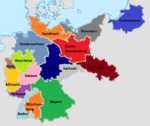Gauliga Berlin-Brandenburg
 |
|
| Country |
|
|---|---|
| Province | |
| Gau (from 1934) | |
| Founded | 1933 |
| Folded | 1945 |
| Replaced by | |
| Level on pyramid | Level 1 |
| Domestic cup(s) | Tschammerpokal |
| Last champions |
Hertha BSC Berlin (1943-44) |
The Gauliga Berlin-Brandenburg was the highest football league in the provinces of Brandenburg and Berlin in the German state of Prussia from 1933 to 1945. Shortly after the formation of the league, the Nazis reorganised the administrative regions in Germany, and the Gaue Brandenburg and Berlin replaced the Prussian provinces.
The league was introduced by the Nazi Sports Office in 1933, after the Nazi take over of power in Germany. It replaced the Oberliga as the highest level of play in German football competitions.
The Gauliga Berlin-Brandenburg was established with twelve clubs, ten from Berlin and two from Brandenburg.
The Gauliga replaced as such the Oberliga Berlin-Brandenburg, the highest league in the region until then.
The clubs from the Berlin/Brandenburg region were not particularly successful in the era from 1933 to 1945. No club reached a German championship or cup final. After Hertha BSC Berlin having played in a record six successive championship finals from 1926 to 1931, this unsuccessful run was a definite decline for the football in Berlin.
In its first season, the league had twelve clubs, playing each other once at home and once away. The league winner qualified for the German championship while the bottom three teams were relegated. The season after, the league was reduced to eleven teams. In 1935-36, it operated with ten clubs and only the bottom two teams being relegated. This modus remained in place until 1939.
In 1939-40, the league played in two separate groups of six teams with a home-and-away final at the end to determine the Berlin-Brandenburg champion.
...
Wikipedia
